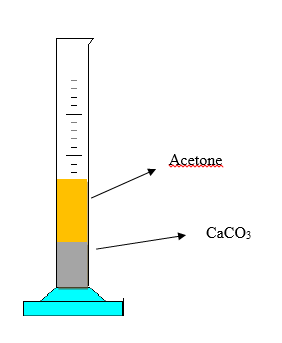Solutions lab
session
During this session you will visit a number of areas
of knowledge that you have used before – precision measurements, properties of
substances, molarity, molality. You will also be introduced to ideas such as
the conservation of mass and additive/non-additive volumes. As you will be
measuring a number of different masses, you should try to use the same set of scales for each
measurement.
Firstly, complete the blank spaces in
the questions below. I have provided enough information to complete all
answers.
Secondly, make a blog page for this
practical that uses the information to discuss the following points (explain
and give examples to support your discussion):
- Is mass always conserved?
- Is volume always conserved?
- What are molality and molarity?
Molarity: is the number of moles of solute per liter of solution.
We have used this formulas, further down in the page.
1.
Working out the volume of 2.5 g sodium
chloride using cyclohexane.
a. Measure 3 mL of cyclohexane with a
pipette and pour it into a dry measuring cylinder.
Weigh the cylinder with the cyclohexane: ___73.50g__.
Weigh 2.50 g of sodium chloride and
place it in the cylinder as well.
Weigh the whole apparatus: ___76.00g_.
Does the total mass equal the masses of
the different parts? _YES___.
A French scientist named Lavoisier
stated that “matter cannot be created or destroyed, so
mass is always conserved”. Does your data agree (approximately) with this statement? __YES___.
b. Why does sodium chloride not dissolve in
cyclohexane (Hint: which kind of
substance are they – ionic, covalent (organic) or metallic)?
It doesn´t dissolve in cyclohexane because is a very
non-polar solvent. It can´t stabilize the NaCl ion because it doesn´t have a
stong enough dipole, nevertheless the water can. It´s a covalent compound.
As it does not dissolve, we can work out
the volume of the salt by measuring the change in volume of the mixture:
What was the initial volume of
cyclohexane? 3mL .
What is the final volume (after adding
the salt)? __4.5mL_.
What is the volume of the sodium
chloride? ___2,5mL.
2.
Is mass conserved when 2.5 g of salt is dissolved
in water?
Weigh a clean, dry 25 mL measuring
cylinder: __70.00g_.
Take 10 mL of water with a pipette and
pour it in the cylinder.
Weigh it again, now with the water: __80.00g_.
What
is the mass of the water? _10mL___.
What should the mass of water be per
gram? (use the internet) _1g. per
mL_.
Weigh 2.50 g of sodium chloride. Add it
to the water and dissolve it.
Weigh the whole apparatus: __82.50g_.
Does
the total mass equal the masses of the different parts? __YES__.
Is mass conserved? __YES___.
What is the final volume of the
solution? __11.0mL__.
3.
Is volume ´additive´ (can we just add
the individual volumes to get the final volume) when 2.5 g sodium chloride is
dissolved in water?
What was the initial volume of water in
part 2? __10mL_.
What volume should be taken up by the salt
solution? __11mL____.
What is the actual final volume of your
sodium chloride solution? ___11mL___.
Is there a difference between your
answer and what you predicted? Explain why there is or might be:
No, I thought that mass cannot be created or
destroyed, but yes modified that´s why even if you add the salt, will weigh the
same.
4. Work out the molarity and molality of the sodium chloride solution:
Molarity, M (mol/L) = number of moles of
solute ÷ volume of solution (L)
Calculate the molarity of your sodium
chloride solution (in water):
10- water
2.5- salt moles=
(mass / atomic mass)
Atomic mass salt: 54,44 moles= (2,5 / 54,44)= 0,04
Atomic mass water: 18
Total moles= 0.04/0.0125= 3.2 moles per litre
Molality,
m (mol/kg) = number of moles ÷ mass
of solvent (kg)
Calculate
the molality of your sodium chloride solution (in water):
3,2 / 0,0025 = 1280 molarity
0,04 /
0.0025= 16 (moles per kg.)
molarity
- Bonus questions
·
Why is it suggested to use the same set
of scales for each measurement?
It is suggested to do it
because some scales are more precise than others, so if we measure some mass
and then another mass in another scale it could be wrong. Not totally wrong but
if we use always the same scale the project will be done with more accuracy.
·
Briefly design a different experiment
that could be used to investigate additive volumes.
This image (that I have made in the computer) represents a measuring cilinder with the two products we have mixed to be able to complete the data. We can try to dissolve CaCO3 in acetone instead of salt in cyclohexane. We need to mearuse the volume of both products to see if once we add both they mix up.
·
What are “colligative properties”?
Are properties of solution that depend on the ratio of the number of
solute particles to the number of solvent molecules in a solution.
- BIBLIOGRAPHY:
.jpg)


The writing in blue at the top explains what you need to do. Please use the data that you have completed in the rest of the page to answer the 3 questions (the blue writing) by giving specific examples. You must also support your answers with other referenced scientific knowledge.
ResponderEliminarThe first bonus question has not been answered!
The second bonus question has not been explained.
References?
Formative B - 2 D - 4 E - 3
Done
ResponderEliminarSUmmative:
ResponderEliminarB - 4 You have still not used specific examples from your data in answering the questions at the beginning.
E - 6 The data has been processed correctly, including units.